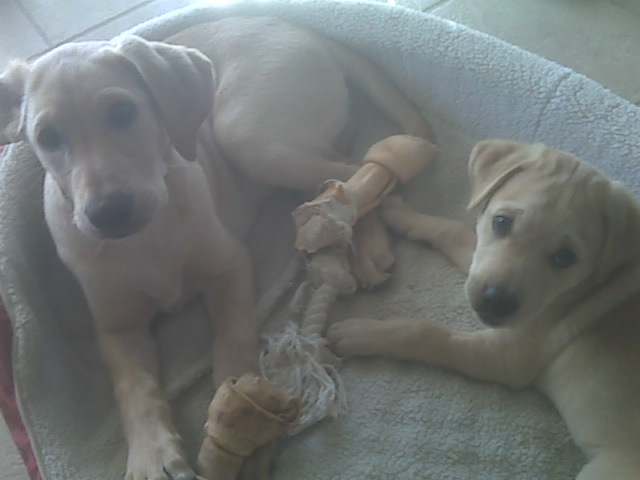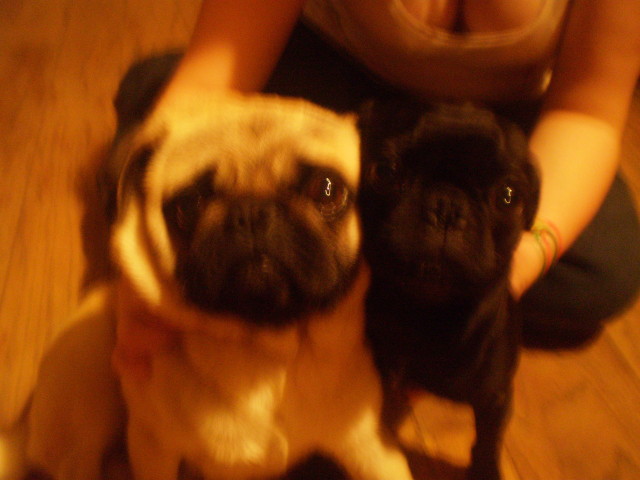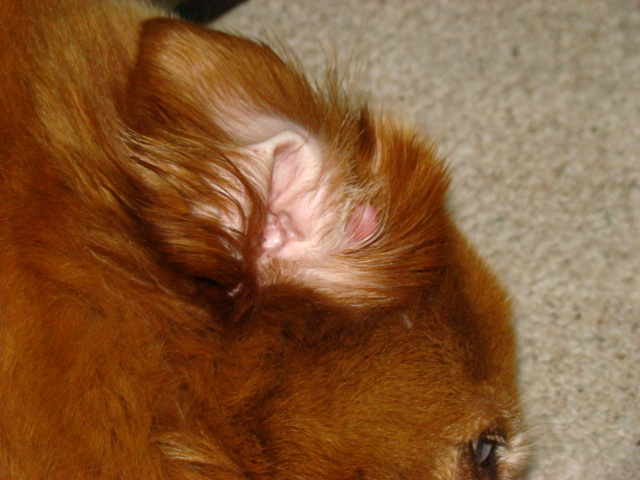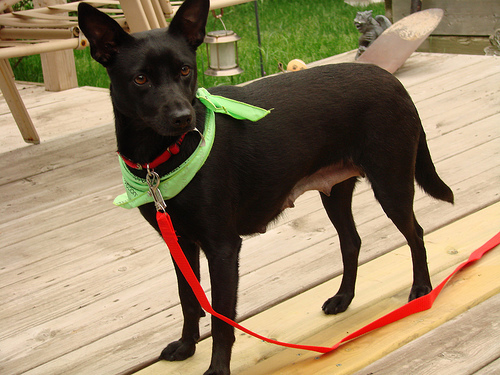QuestionHi, I walk my lab everyday unless its very cold or very rainy. We just go around the block once or twice. I was walking her with a choker for the last two months but seeing as she was still pulling a bit anyways she was just choking herself so I decided to walk her with a flat collar, well the first day I did it went fine she still thought she was on the choker I think, but yesterday oh my! she was pulling me around, I pulled back & even stopped and turned around like I've heard people say to confuse the dog into not pulling well it didn't work, needless to say I told her she was going to have to wear her choker tomarrow if she wanted to walk again. I was wondering if I could train her to heel during these daily walks? how is it done? can I use the choker for this? is there a certin way to use a choker collar to correct her or anything because she just pulls until she chokes herself most of the time. Any advice will be greatly apprecated. Oh on another note is it normal for my jack russle to be mounting the spayed females? he also comes and bites my lab when I'm petting her and vice versa but he gets more upset. Also while the wresle he bites her neck and sometimes so much she drys her growls slightly while doing this and pins her to the back of th couch by pushing his weight on her.... why is he doing this? can it be stopped? I hope to here from you soon, thanks again Kristen, ~ Tara.
AnswerHi, Tara. I’ll address the issues with your Jack Russell first. Going out on a limb, I would guess that he’s unaltered (not neutered). His behavior is typical of a dog that wants to be alpha (in charge) and is very demanding in asserting that fact. The mounting behavior has nothing to do with sex or desire to reproduce; it is him asserting himself as alpha over the others. The same with the biting of your lab while you are showing her attention and not him. I’m confused by your next statement – are you saying the Jack Russell is pinning the Lab against the back of the couch? I find that hard to believe, but this is pretty normal play behavior. The more submissive dog will allow the more dominant dog to push him (or her) around. If the Jack Russell is not neutered, that may help to solve these problems, as well as you taking charge and assuming the alpha position instead of him. The “Nothing in Life is Free (NILIF)� program (also called “No Free Lunch�) is something that I recommend to everyone, because it is very effective at showing your dog that you are in charge, without being physical with the dog or risking being bitten. Here are a few links that you should check out:
http://k9deb.com/nilif.htm
http://www.greyhoundlist.org/nothing_is_free.htm
http://www.k9force.net/nilif.html
www.ddfl.org/behavior/nilif.htm
This is a starting point for you; if you go to www.google.com and do a search for “nothing in life is free� or “nilif� you should get a lot more links to look at, too. What you need to start doing is correcting him for mounting the other dogs, or biting at them when you pet them instead of him. Do this by saying “[Name], NO� and either squirting him with a water bottle set to ‘stream’ or taking hold of his collar and very quickly tugging and releasing (this is the same concept as a leash pop – a very quick jerk and release to reinforce your verbal reprimand). If it’s mounting he’s doing, tell him no and physically remove him from the other dog. Repeat as necessary, but if he goes right back to humping the other dog after 3 or 4 times, put him in his crate or in another room, isolated from you and them, for a few minutes. If he barks or howls, ignore him. Do not let him back out until he is quiet.
Now, on to your lab!
Teaching heel can be easy or hard, and is completely up to you! Personally, I do not use or recommend the choke collar because it can be very dangerous, and usually does not work (as you can attest to). Instead, and especially for leash manners, I recommend and use the prong or pinch collar. The web site http://www.leerburg.com/fit-prong.htm shows you how to correctly fit the collar, and my web site at http://www.angelfire.com/tx6/shrinercpa/prongpics.html shows the collar correctly and incorrectly fitted on a few different breeds of dogs. Basically, the collar should fit snugly on the top part of the neck just behind the ears. It should not be tight and restrict breathing, but it should be snug enough not to move around or fall down on the neck. A size medium is a good size for a Labrador, and you can also buy vinyl tips to put over the ends of the prongs if you’re worried that the bare prongs will scratch or irritate her skin. I do not, under any circumstances advocate the use of the choke chain or slip collar. These collars are not only more difficult to use, but they are very harmful to the dog as well. The prong, despite its looks, is actually much more humane than any other training collar on the market today. Following are some of the differences between the prong and choke collars:
1. A prong collar has a limited slip (like a martingale-style greyhound collar). This means that it can only tighten so far. This feature prevents the dog from having the breath choked out of him. It also prevents neck injuries that can be caused by choke chains, such as a collapsing trachea, soft tissue damage, and damage to the spine. Radiographs (X-rays) of dogs that have been trained with choke chains have shown misalignment of the cervical vertebrae, and choke chains have also resulted in injured ocular blood vessels (blood vessels in the eyes), severely sprained necks, fainting, transient foreleg paralysis, laryngeal nerve paralysis, and hind leg ataxia.
2. A prong collar cannot be put on backwards like a choke chain can. When a choke chain is put on backwards, once it is tightened, it does not release. This means that the user is continually 'correcting' the dog even after the correction has already been given. This is not only confusing and frustrating to the dog, but it can also be very harmful. Since the collar isn't releasing, the dog has trouble getting enough oxygen and may start to cough and hack, or even pass out.
3. A prong collar does not require NEAR the amount of 'force' during a correction, in order to be effective. With a choke chain, the user has to make a very precise movement, and jerk the leash to administer a correction. With a prong, all the user has to do is usually just a flick of the wrist for training in basic obedience or for teaching good leash manners.
4. A prong collar distributes a correction evenly all the way around the dog's neck, simulating the way one dog would correct another by biting the other's neck. A choke chain has only one correction point - the ring (where it left the bruise on my leg, see below). That's why so much force is needed for a correction with a choke chain to be effective.
Before actually using a training collar on your dog, I recommend to everyone that they go to the store and try it out on themselves first – on their thigh. I did the same thing more than 3 years ago and I haven’t touched a choke chain since. I was wearing shorts when I did it. I got a medium sized prong collar and fitted it to my thigh so it was snug enough not to fall off when I let go. I hooked a leash to the live ring and gave a few gentle tugs. Surprisingly, it wasn't painful, even when I yanked on it a couple of times; of course, it wasn't a pleasant sensation, but it didn't hurt either. It left no long-term marks either (just a few light pink marks that went away in the amount of time it took me to take the collar off). I did the same thing with the choke chain (placed correctly, in the shape of a P) on my other leg, and ended up with a nasty bruise/pinch mark where the ring of the collar was (it actually pulled some of my skin through the ring with the collar when I 'corrected' with it!). It HURT, let me tell you!
Also please take a look at the following sites:
http://www.dru.org/prongcollar.htm - A doberman rescue organization’s website
www.cobankopegi.com/prong.html
www.canismajor.com/dog/prong.html
http://www.flyingdogpress.com/prong.html
Ok, now that you’ve had your prong collar vs. choke collar lesson, we can move on. ;^)
Let your dog wear the collar around the house for a few days before you actually take her out for a walk with it – that way she will not learn to associate the collar with going for a walk, and it will be easier to wean her off of it and back onto a regular flat collar when she’s ready. Do not leave the collar on her unsupervised, but only when you are home and able to keep an eye on her, just in case it were to get hung up on something. It won’t choke her to death like a choke chain would, but it may cause a fear of whatever item she gets hung on.
After a few days, go ahead and start out as normal (except if you normally use a retractable leash, you’ll need to stop and get a 4 or 6 foot long leather or cloth leash to use). Take along some treats and be prepared to not get very far on the first few walks, so don’t start out expecting to walk around the block a few times. You may only get down the street and back. I like Pup-per-oni for teaching heel because you can hold the entire stick in your hand and just leave a tiny bit sticking out between your fingers. Whatever you use should be something she really likes, and you should preferably not give it to her except when working on teaching her to heel.
Hold the treat in your right hand, and the leash in your left (if she is going to be walking on your left). Hold the leash so that if she is standing or sitting by your side, with her right leg even with your left, there is only a tiny bit of slack in the leash. The leash clip should be hanging straight down, with about an inch of leash before it forms a U and goes up towards your hand. Again, I can send you a picture if you like. Let just enough of the treat show between your fingers so she can sniff it, and even nibble at it, but not get it. Hold your arm across your body with your hand approximately where your left leg joins your body (or a little higher if her head is that high). You want the treat to be just above nose-height so she has to look slightly up at you. Don’t hold it so high up that she’s jumping up and all over you to get the treat, though. I can e-mail you some pictures of what you and your dog should look like if you want me to, but you’ll have to send me a personal e-mail at 14trrgi02@sneakemail.com because AllExperts does not allow you to send photos. Anyway, start out by letting her sniff the treat, then placing it in the position I described, and saying “[Her name], Heel!� in a commanding, but not low and harsh, tone of voice. Say it like you mean it, but not like you’re scolding her. She should be licking and nibbling and trying to get the treat, so as soon as you say heel, take a few steps forward (3-5 steps is fine) and then stop. At this point, don’t worry whether she sits when you stop; you’re just teaching her the position right now. Praise her and let her have just a tiny piece (half a fingernail length or less) of the treat. Repeat the command, saying her name first, and go a few more steps. If she’s staying in position, you can take as many as 10 steps before you stop and let her have a piece of the treat. If she lags behind, or tries to run forward, or to the side, or stop and sniff something or otherwise breaks position, verbally correct her with a “[Name], No. Heel.� and use the leash to encourage her back to position by giving a few quick tug, tug, tugs in whatever direction will bring her back to the correct position. If you’re holding the leash properly, the way I described above, then she shouldn’t be able to get far out of position before the leash tightens. When you notice this, extend your arm just a little, so you are putting a little slack back in the leash before every tug. If the leash remains tight, then your corrections are not going to be effective.
Repeat this anywhere from 5 to 10 times, and always end on a good note. For example, say you’ve repeated the stop and go, luring her with a treat 6 times, but on the 7th and 8th times, she seems uninterested, or keeps breaking position. Make the 9th time your final time, and only take 2 or 3 steps before stopping. Do not ever end a training session when the dog is failing to perform correctly. If this happens, take a step or two back to when the dog was performing correctly, and then quit. After the last time, give her a release command so she knows she is not required to heel when you step off again. I use “You’re through� as my release command, but you can use anything you want. Just say “[Name], you’re through,� or “[Name], that’s all� or whatever. Then just turn and walk away. Leave the leash on her for a few minutes though, so she doesn’t start to learn that when you take off the leash she can just do whatever. Take it off after a minute or two, and then take the collar off 10-15 minutes later.
Again, if you want pictures, let me know by e-mailing me at: 14trrgi02@sneakemail.com
This is just the beginning steps. If you’ll e-mail me privately, I will instruct you through all of the steps as you and your dog are ready for them. :^)
Kristen

 2 puppies one lab the other lab/shepherd mix
Question
Bailey ( female lab) a
I have a 3 1/2 month ol
2 puppies one lab the other lab/shepherd mix
Question
Bailey ( female lab) a
I have a 3 1/2 month ol
 pugs
Question
micah and lacy
my male and female are the same
pugs
Question
micah and lacy
my male and female are the same
 Ear Care
Question
Erins Ear 2
I had my dog groomed two days ago
Ear Care
Question
Erins Ear 2
I had my dog groomed two days ago
 Guessing my dogs mix
Question
matilda
I was wondering if you could help what
Guessing my dogs mix
Question
matilda
I was wondering if you could help what
 10 week old Pitbull Pup
Question
Ares
I have a few questions =]
Why does he ke
10 week old Pitbull Pup
Question
Ares
I have a few questions =]
Why does he ke